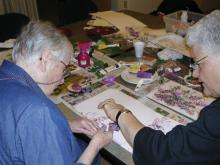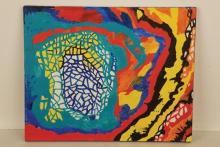BARCELONA – Long-term care facilities in British Columbia have the material resources to offer a variety of creative-expression programs for patients, but only a few have implemented such programs.
In a survey of 120 centers that provide care for patients with dementia, about 50% offered programs that involve any kind of creative expression, Peter Graf, Ph.D., and Dalia Gottlieb-Tanaka, Ph.D., said in posters presented at the International Conference on Alzheimer’s and Parkinson’s Disease.
"Activities with a creative dimension encourage the development of new ways of communicating and new ways of interacting with others," Dr. Graf said in an interview.
The 10-page survey asked respondents to detail the nature of their activity programs, the staff that conduct them, and the patients who attend them, said Dr. Graf of the Memory and Cognition Laboratory at the University of British Columbia, Vancouver. He presented data on 80 of the centers that responded to the survey; the province has more than 1,000 that provide care for patients with dementia.
The survey conducted by the colleagues found that pet therapy was the next most commonly offered (42%), followed by group singing (31%), and art (24%). Group reminiscence, horticulture, dance poetry, aromatherapy, one-on-one creative-expression work, healing touch, drama, and poetry were least likely to be available.
Although more than 60% of centers had at least some of the materials necessary to carry out one or more of those activities, the materials were available for many fewer patients. For example, 60% of centers reported having art supplies that staff could use in an art program, yet they were available to less than 40% of patients. The findings were similar for other materials, including music and song books (62% of staff, 50% of patients), art books (40% and 35%), and other art supplies.
Respondents rated social interaction and improvement in quality of life as the two most important benefits of creative-expression programs. Other highly rated benefits were cognition and positive affect. Least important were the acquisition of new skills and the promotion of self-awareness.
"This is a very significant finding, which points out that even care facilitators do not expect any skills improvements and abilities in self-expression," Dr. Gottlieb-Tanaka said. "These are the thoughts that limit the provision ... development of, and access to, creative-expression programs. Research proves that people with dementia are capable of expressing themselves in many ways, and it is up to us to notice it and use it in an effort to communicate with them."
Despite the relative dearth of programs, respondents said even those with severe dementia are able to participate in meaningful ways. "Creative activities serve to open up new ways for expressing feelings, emotions, worries, when other methods have succumbed," Dr. Graf said. This was particularly true for music and singing programs.
The activities also are offered to persons without dementia, and they made up the bulk of participants in all categories measured. But, in music therapy, singing, pet therapy, and art therapy, patients with mild cognitive impairment and mild and moderate dementia still participated freely. Patients with severe dementia were more likely to be included in pet therapy, touch, and aromatherapy – more passive expression programs. "These kinds of programs are more likely to be provided on a one-on-one basis," Dr. Graf noted.
Some real-world findings mirrored those in a meta-analysis of literature on the subject, said Dr. Gottlieb-Tanaka, founder of the Society for the Arts in Dementia Care in British Columbia.
She reviewed 98 selected articles published during 2000-2010. The most commonly employed activities she saw were a mixture of art, music, and reminiscence. The majority were scheduled once a week.
Although certified facilitators ran most of the groups (about 27%), volunteers ran about 10% of the programs. "Canada is fortunate to have a strong volunteer community," she said. "Many facilities in British Columbia count on volunteer work, especially in remote communities." Some studies support using trained volunteers and see no significant differences between certified facilitators or trained volunteers, she added.
Unfortunately, said Dr. Gottlieb-Tanaka, about half of the programs, in her opinion, were not creatively engaging. "A variety of creative-expression activities needs to be offered every day and planned to fit personal needs, preferences, level of dementia, and physical and mental abilities. Not only that, the programs need to take into account life history, likes and dislikes, and be flexible enough to accommodate changes as the condition progresses."


